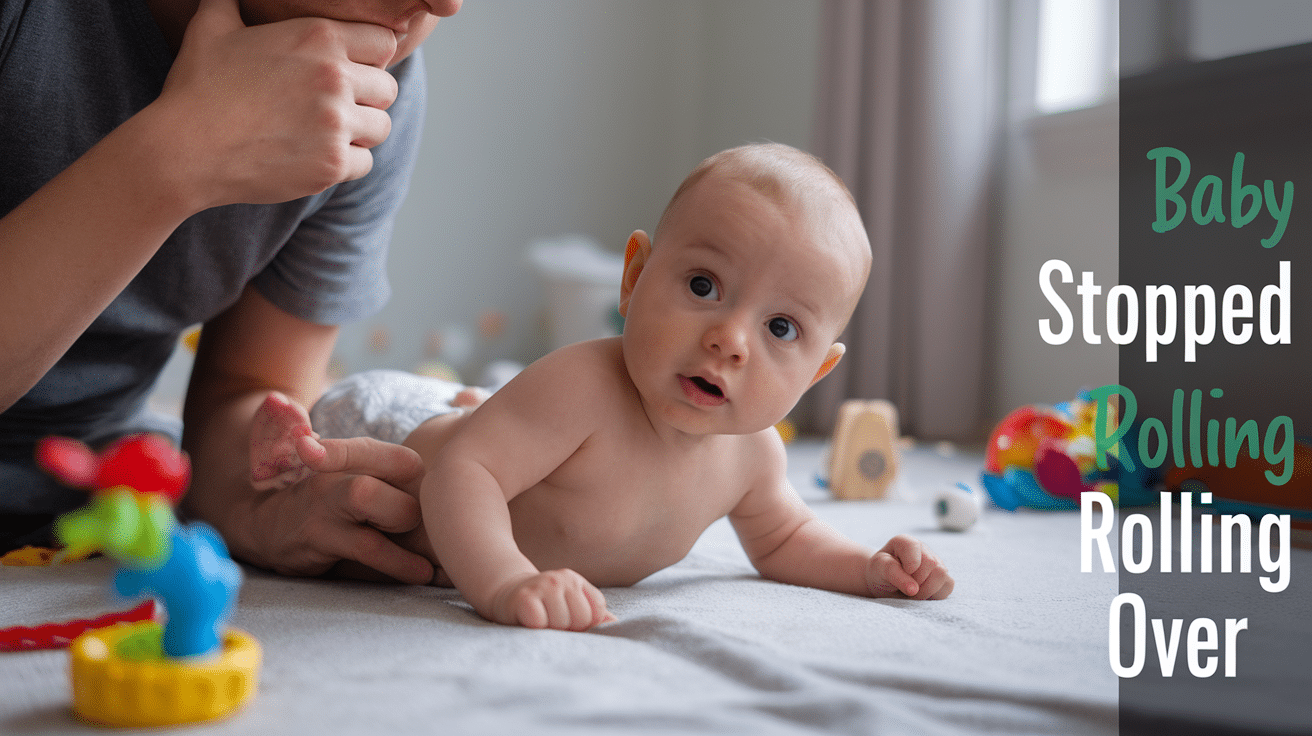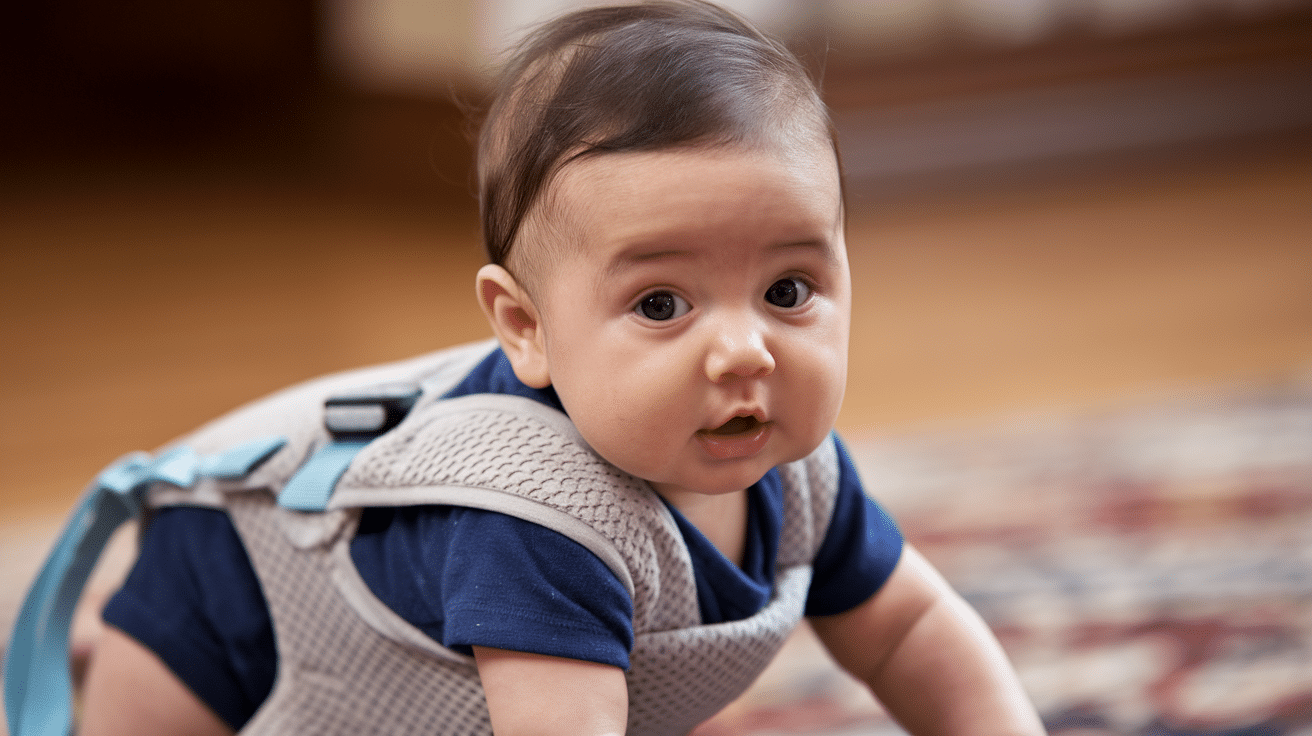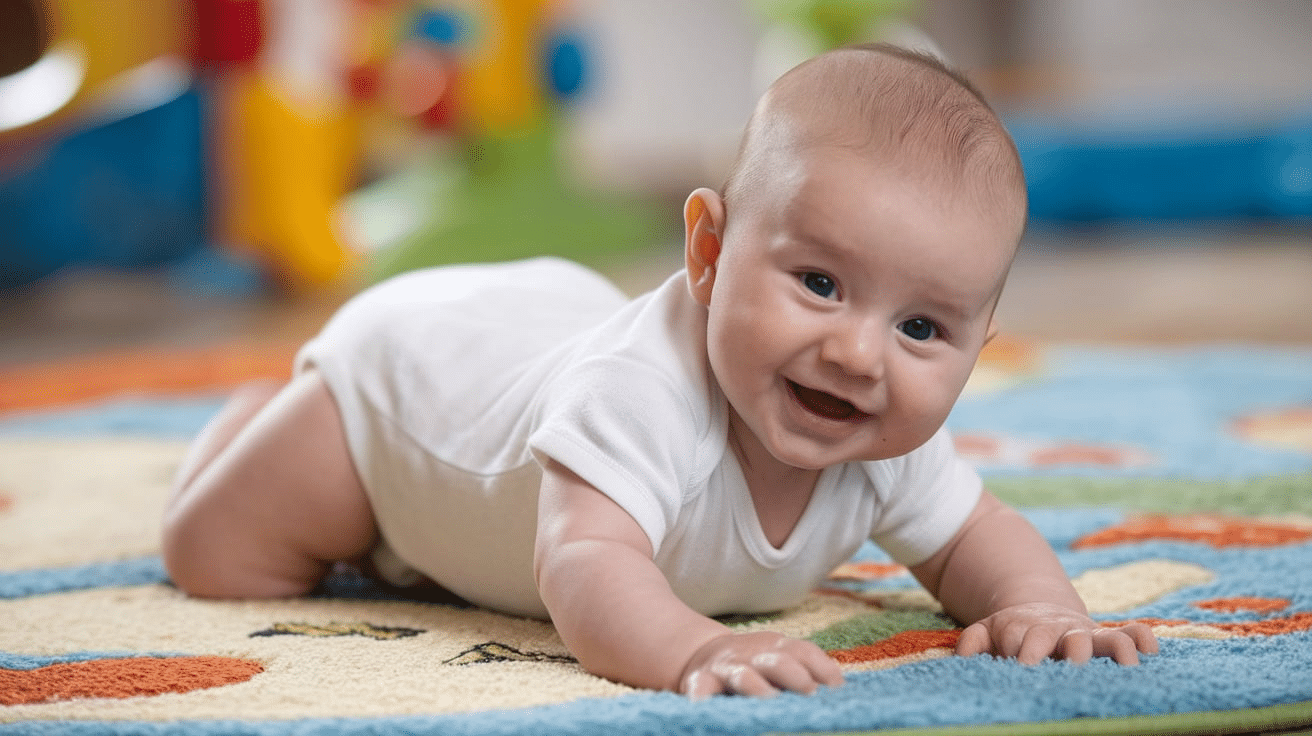
When your baby suddenly stops rolling over, it’s natural to worry. Rolling is an important milestone that shows that your baby’s muscles are strengthening.
Most babies start rolling from their tummy to back at around 4 months and from back to tummy between 5-6 months. Sometimes, babies who have been moving well may take a break from this skill.
This pause can be due to many simple reasons – your baby might be busy learning to sit, crawl, or just be more interested in other things.
While this is often normal, it’s helpful to know when a break in rolling might need a doctor’s check. In this guide, we’ll explain why babies stop rolling, what’s normal, and when to talk to your pediatrician.
We’ll also share tips to help support your baby’s rolling skills.
Understanding Why Babies Roll Over

Rolling over is an exciting milestone between 4 and 7 months of age, marking a significant step in your baby’s physical development.
This simple movement demonstrates your little one’s growing strength, coordination, and spatial awareness.
Most babies master rolling from tummy to back first, usually around 4 months, as it requires less muscle control. This early roll often happens accidentally as babies lift their heads during tummy time.
Rolling from back to tummy typically develops around 5-7 months and is more challenging because it requires a stronger neck, arm, and core muscles.
Why Rolling Is Important for Babies?

Rolling is one of the first ways babies learn to move independently. It helps babies understand how their body moves and builds the strength they need for other movements like crawling and sitting.
Babies use their neck, back, tummy, and arm muscles together when they roll.
This movement also helps them learn where their body is in space – something we call body awareness. Rolling gives babies their first taste of independence and lets them explore the world around them.
Benefits of Rolling
- Rolling strengthens core muscles and helps develop head control, essential for sitting, crawling, and walking.
- Rolling helps babies to cross their body’s midline (imagine a line down the center of the body), which is important for reaching, writing, and other daily activities.
- Rolling gives babies a new way to view their surroundings, helping their visual development and encouraging them to explore and learn about their environment.
Rolling is more than just a milestone – it’s a building block for your baby’s physical development and learning. Each time your baby rolls, they’re developing skills that will help them move and learn in new ways.
Common Reasons Babies Stop Rolling Over

Babies might take breaks from rolling over as they learn new skills like sitting, crawling, or pulling up. This is normal and shows they’re focusing their energy on different types of movement.
Sometimes, babies get so interested in practicing one skill that they temporarily set aside others. For example, your baby might focus more on reaching for toys or trying to scoot forward than rolling over.
Physical growth spurts can also affect movement patterns – your baby might need time to adjust to their changing body and strength. Environmental factors like harder surfaces or less tummy time can influence rolling behavior.
Why Babies Stop Rolling
- New skill development: Your baby might pause rolling while mastering sitting up, crawling, or other movement milestones that need their attention and energy
- Growth and physical changes: Weight gain, growth spurts, or changes in muscle strength can temporarily affect how your baby moves and rolls
- Environmental factors: Changes in play surfaces, daily routines, or available tummy time can impact your baby’s rolling habits and overall movement patterns
How to Encourage Rolling Again?

To help your baby rediscover rolling, focus on creating engaging opportunities for movement throughout the day. Here are some activities that you can do to encourage your baby to start moving again-
- Dedicate ample time to tummy position and unrestricted floor play, strengthening core muscles essential for rolling.
- Use toys and mirrors strategically during these sessions by placing them slightly out of reach to encourage natural movement.
- Make side-lying a part of your daily routine by gently positioning your baby on their side with support.
- Keep play spaces interesting by incorporating different textures and surfaces – try blankets, play mats, or carpets. This variety helps develop your baby’s sensory awareness and movement confidence.
- Minimize time in restrictive equipment like car seats, swings, or chairs when at home. Instead, prioritize free movement opportunities where your baby can practice their physical skills naturally.
Quick Tip: Use these position tips during diaper changes or playtime to help them become comfortable with the transitional poses needed for rolling.
When to Call the Pediatrician

While every baby develops independently, certain signs warrant a discussion with your pediatrician. Contact your doctor:
- If your baby stops rolling for several weeks without developing new skills like sitting or crawling instead
- When previously mastered skills disappear, this could indicate reverse development.
- If you notice your baby has uneven movements, muscle stiffness, or seems weaker on one side
- When your 6-month-old hasn’t started rolling yet and also shows delays in other physical movements like pushing up during tummy time
Remember, early intervention is key for addressing any potential developmental concerns. Always trust your parental instincts – if something doesn’t feel right about your baby’s development, it’s better to check it.
Your pediatrician can properly assess your child’s progress and provide guidance or referrals if needed.
What a Pediatrician May Assess?
During a checkup focused on your baby’s rolling abilities, your pediatrician conducts several key evaluations. They carefully examine muscle tone throughout your baby’s body, checking if muscles are too tight or loose, as this affects movement quality.
The doctor also assesses flexibility in the neck, back, and limbs. Your pediatrician tests for persistent primitive reflexes that could stop rolling progress.
While normal in newborns, these involuntary movements should gradually fade to allow for controlled movement.
Physical Limitations Which Require Special Attention

Some babies may face physical challenges that affect their rolling development and need extra support from parents and healthcare providers. If your baby has low muscle tone (hypotonia) or high muscle tone (hypertonia), they might need more time and specific exercises to master rolling.
Head size can also impact rolling – babies with larger heads might need extra neck strength to roll successfully.
- Torticollis: A condition where neck muscles are tight on one side, making it harder for babies to turn their head and roll in both directions
- Plagiocephaly: Flat spots on the head that can affect neck movement and make rolling more challenging in certain directions
- Medical Equipment: Babies who use feeding tubes, oxygen, or other medical devices may need modified approaches to rolling
Always work with your pediatrician or physical therapist to develop safe strategies that support your baby’s unique needs. They can provide specific exercises and positioning techniques tailored to your baby’s condition.
Final Words
Remember that every baby develops at their own pace, and taking breaks from rolling is often normal. Keep an eye on your baby’s overall development and trust your instincts.
If your baby stopped rolling over for more than 2-3 weeks, or you notice other changes in their movement, talk to your pediatrician.
They can check for concerns and suggest ways to help your baby’s development. In the meantime, continue tummy time, play on both sides, and make floor time fun with toys and interaction.
Most importantly, stay calm – your baby is learning and growing daily, even when progress isn’t obvious.
With patience, support, and guidance when needed, your little ones will continue to reach their movement milestones.
Frequently Asked Questions (FAQs)
How Long Should I Wait Before Getting Concerned?
A pause for 1-2 weeks is normal as babies focus on new skills. However, seek pediatric advice if rolling stops for more than 2-3 weeks or if accompanied by other developmental changes.
How Can I Tell if My Baby Prefers One Side?
Observe your baby during playtime for consistent head turning to one side, rolling in only one direction, favoring one hand for reaching, or resistance when turning their head to the opposite side.
What if My Baby Only Rolls in One Direction?
While initially mastering one direction is normal, persistent one-sided rolling should be discussed with your pediatrician.
It could indicate muscle imbalances or preferences that need addressing through targeted play and exercises.
